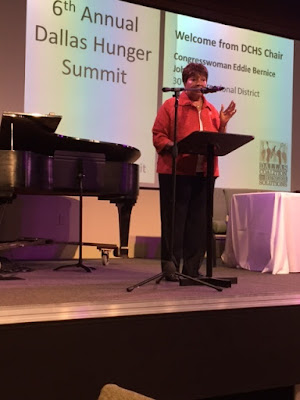When
Evening Arrives and There Is No Bread
Matthew
14:15-21
Dallas
Hunger Summit ▪ September 15, 2017
Dallas Coalition for Hunger Solutions
Introduction:
·
It
is an honor to stand with you today
·
Knowing
your work, your tenacity, your commitment and your faith, I am truly humbled to
be with you
·
You
guys happen to be my heroes!
____________________________
·
I
also know that none of you are satisfied with where we are today
·
When
we get together, we typically hear the dismal, disheartening, depressing
numbers—I’m sure we’ll hear them again today
·
I
trust and hope that the numbers will bring challenge and renewed determination.
·
But,
we’ve got issues, don’t we?
--runaway obesity
--malnutrition
--toxic stress related to food insecurity
--life in food deserts all across this great,
wealthy city
--hunger
_____________________________________
What are we
going to do?
Forgive me, but
I’m going to tell a “Jesus story”!
Not a church
story. . .
Not a
proselytizing story. . .
But a story of
mystery, power and fulfillment!
Is that
Okay?
_____________________________________
Here it is:
When it was evening, the disciples came to him and
said, “This is a deserted place, and the hour is now late; send the crowds away
so that they may go into the villages and buy food for themselves.” 16 Jesus
said to them, “They need not go away; you give them something to eat.” 17 They
replied, “We have nothing here but five loaves and two fish.” 18 And
he said, “Bring them here to me.” 19 Then he ordered the crowds
to sit down on the grass. Taking the five loaves and the two fish, he looked up
to heaven, and blessed and broke the loaves, and gave them to the disciples,
and the disciples gave them to the crowds. 20 And all ate and
were filled; and they took up what was left over of the broken pieces, twelve
baskets full. 21 And those who ate were about five thousand
men, besides women and children.
Now what might
we observe here?
1.
At the end of the day hungry people too
often find themselves in a desert
without food!
2.
At the end of
the day hungry people
too often are dismissed by their leaders.
. .those with resources and authority who now claim they have no remedy for
hunger in the desert!
3.
At the end of
the day hungry people, including children, find it normal to be “on their own”
to find food to satisfy their hunger—not only “send them away,” but also let
them buy food for themselves in the surrounding villages.
4.
At the end of
the day, those with power face the hunger issue with a well-developed “scarcity
mindset”—look how little we have here, 5 loaves and two fish!
But in the
story, Jesus represents something so amazing:
intervention, innovation, insistence, direct
action!
1.
You are responsible!
--Bring what you
have!
--Here is where
I get lost, frankly—but the mystery of the miracle answers our need perfectly—I’m
lost, but I feel right at home! I’ve
been lost for 40 years when it comes to hunger and affluent America!
--We’re in a
desert with not enough resources
--We’re
underfunded for the challenge
--We’re
ineffective much of the time
2.
I notice that Jesus gets them organized—he has
them sit on the ground in groups—Mark’s version has them in groups of 100s and
50s: I wonder how much community
organizing might have been going on here? Something about folk getting’ together over
food!
3.
At the end of
the day, there was more than enough thanks to faith and action—I expect a
lesson for Jesus’ followers!
___________________________________________
For me, this
story forces and inspires a new conversation about the challenge of hunger in
our community and our nation:
·
We need new
strategies
·
We need
empowering impatience
·
We need to ask
hard questions
For example:
► Why can’t we
develop plans for strategically located, full-service grocery stores in our
food deserts that includes whatever subsidy is necessary to attract and retain
these merchants?
► Today we can
calculate the economic impact of notorious food on community health. Why not take some public health $$$ and apply
to the preventative work of the availability of good grocery stores?
► Why can’t we
mobilize and deploy all of our SNAP benefits in Texas and in Dallas? Full mobilization of food benefits would help
fund grocery markets in the places where most needed.
► Why not reward
community gardeners with supply grants and other field to market cost supports
to ensure these endeavors survive and thrive?
► Why can food
centers and neighborhood pantries better coordinate their work to increase impact?
Why can’t we replace competition with
cooperation?
Conclusion:
1.
I’ve been
watching, knowing, hearing hungry and poor folks for over 4 decades—I’ve got so
many memories:
--Mr. Adrian in
New Orleans
--The precious
folks who line up outside our food center daily. . .waiting so patiently for
our groceries
--Almost 25
years ago in East Dallas, the little boy and his younger brother with the
single banana
--The kids we see
after school and all summer long
2.
Your work is
hard.
Please don’t
give up—you are in good company!
Embrace the
challenge—you’ll likely find and encounter the mystery.





No comments:
Post a Comment